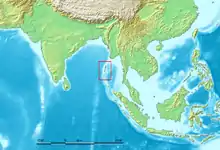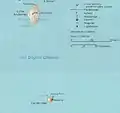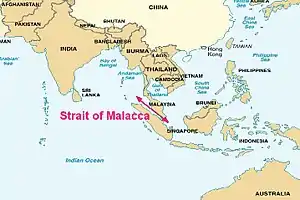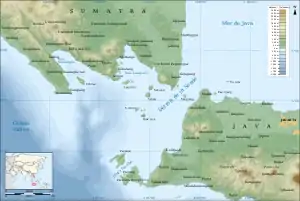Lombok Strait
The Lombok Strait (Indonesian: Selat Lombok), is a strait connecting the Java Sea to the Indian Ocean, and is located between the islands of Bali and Lombok in Indonesia. The Gili Islands are on the Lombok side.
| Lombok Strait | |
|---|---|
 | |
 Lombok Strait | |
| Coordinates | 8°46′S 115°44′E |
| Type | strait |
| Basin countries | Indonesia |
| Max. length | 60 km (37 mi) |
| Max. width | 40 km (25 mi) |
| Min. width | 20 km (12 mi) |
| Average depth | 250 m (820 ft) |
| Islands | Gili Islands |
Its narrowest point is at its southern opening, with a width of about 20 km (12 miles) between the islands of Lombok and Nusa Penida, in the middle of the strait. At the northern opening, it is 40 km (25 miles) across. Its total length is about 60 km (37 miles). Because it is minimum 250 m (820 feet) deep[1] — much deeper than the Strait of Malacca — ships that draw too much water to pass through Malacca (so-called "post Malaccamax" vessels) often use the Lombok Strait, instead.
The Lombok Strait is notable as one of the main passages for the Indonesian Throughflow that exchanges water between the Indian Ocean and the Pacific Ocean.
It is also part of the biogeographical boundary between the fauna of the Indomalayan realm and the distinctly different fauna of Australasia. The boundary is known as the Wallace Line, for Alfred Russel Wallace, who first remarked upon the striking difference between animals of Indomalaya and those of Australasia and how abrupt the boundary was between the two biomes.
Biologists believe it was the depth of the Lombok Strait itself that kept the animals on either side isolated from one another. When sea levels dropped during the Pleistocene ice age, the islands of Bali, Java and Sumatra were all connected to one another and to the mainland of Asia. They shared the Asian fauna. The Lombok Strait's deep water kept Lombok and the Lesser Sunda archipelago isolated from the Asian mainland. These islands were, instead, colonized by Australasian fauna.
Gallery of nearby important channels

 Cocos Strait, Duncan Passage and other Indian channels
Cocos Strait, Duncan Passage and other Indian channels Cocos Strait is at the northern end of Andaman Islands in red square
Cocos Strait is at the northern end of Andaman Islands in red square Ten Degrees Channel
Ten Degrees Channel Ten Degrees Channel, closeup
Ten Degrees Channel, closeup




See also
- Geostrategic context
- Andaman and Nicobar Command
- Andaman Sea
- Bay of Bengal
- Exclusive economic zone of Indonesia
- Exclusive economic zone of India
- Local context
- Alas Strait, on the opposite side (east) of Lombok
- Sunda Strait
- Makassar Strait
- Wallace Line
Notes
- Susanto, R. Dwi; Leonid Mitnik; Quanan Zheng (December 2005). "Ocean Internal Waves Observed in the Lombok Strait" (PDF). Oceanography. p. 83. Archived from the original (PDF) on 9 October 2011. Retrieved 16 May 2008.
References
- van Oosterzee, Penny (1997). Where Worlds Collide: the Wallace Line.
- Pleistocene Sea Level Maps
- Wallacea - a transition zone from Asia to Australia, specially rich in marine life and on land.
- Dawkins, Richard (2004). The Ancestors Tale. Weidenfeld & Nicolson. ISBN 0-7538-1996-1. Chapter 14 - Marsupials.
| Wikimedia Commons has media related to Lombok Strait. |
